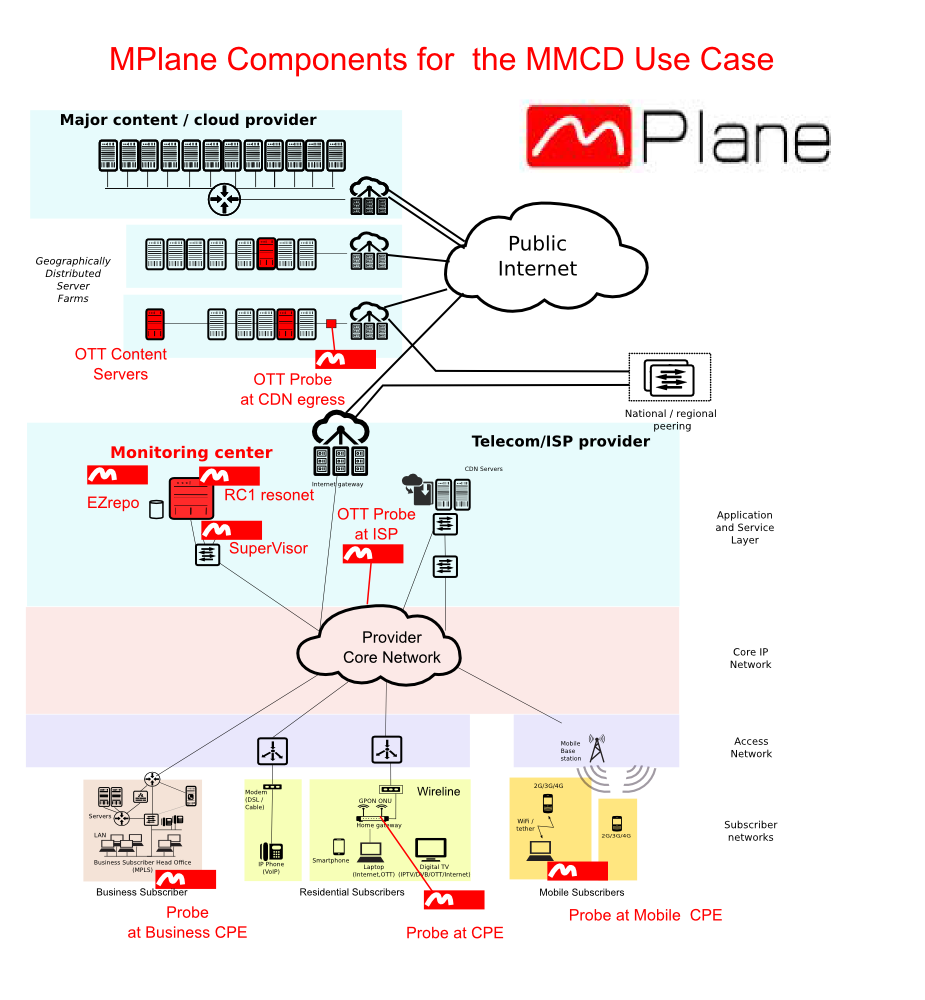- ABOUT MPLANE
- NEWS
- Blogs
- EXTERNAL ADVISORY BOARD
- PUBLIC DELIVERABLES
- PUBLICATIONS
- TALKS
- STANDARDIZATION
- CALENDAR & EVENTS
- CONTACTS
- mPlane Industrial Workshop
- 1st PhD school on BigData
- EuCNC 2015 Exhibition
- Open Datasets
- SOFTWARE
- Demonstration guidelines
- Use cases
- Content Popularity Estimation
- Anomaly detection and root cause analysis
- Passive Content Promotion and Curation
- Active measurements for multimedia content delivery
- Quality of Experience for web browsing
- Mobile network performance issue cause analysis
- Verification and certification of service-level agreements
- mPlane Final Workshop
You are here
Active Measurements for Multimedia Content Delivery Analysis
Use Case Overview
The multimedia content delivery UC aims to provide a mechanism for service assurance for providers (telecommunication AND content providers) and also a tool for end customers to get an early notification and analysis of problems they may have encountered.
This mechanism is based on a set of coopearating probes from different technologies and a supervisor with reasoner that initiate an "investigation session" -- i.e. root cause analysis action--, once media delivery problems are detected, or such a problem is indicated by a user.
A principal goal of the Multimedia content delivery use case is to demonstrate the cooperation and orchestration of several probe types from various partners, i.e. prove that a compound of information delivered by probes that test and investigate a networking scenario from multiple aspects can efficiently be applied for the practical identification of typical network quality problem.

Demo strategy
The demostration will present various multimedia content sources (OTT servers) and various clients consuming such contents. It is shown that errors introduced at various points in the delivery chain cause errors or degradation in the service. The Reasoner being informed of the problem (i.e from probe measurements or through input of an external notification), will instruct the Supervisor to collect information from probes operating in the near past, and also initiate a detailed analysis by activating further measurements on other probes.
Collecting the information from these probe sources will gradually allow the probe to present a diagnosis of growing confidence level. Total analysis time is expected to range between 20-120 seconds in typical situations. The evolution of the diagnosis is constantly presented by the reasoner status, and, upon reaching a certain confidence threshold, notifications are also sent to
affected clients. (These clients subscribe to patterns of notifications, allowing a selective notification for different parties).
The storyboard of the demostration is as follows:
- Demonstrating the normal service scenario, 2 content delivery servers (OTT servers) also representing 2 different CDN hubs will deliver multiple video content titles (some on-demand, some live contents), and 4-6 clients (mobile and fixed clients) will access these titles in an arbitrary pattern. Viewer experience is fair at all clients.
- The demo scenario will allow for simulation of various issues
- Content missing from either or both CDN servers
- Operational or performace problem at either server
- Degradation of individual access lines, or degradation at the aggregated/core network segments that affect multiple viewers simultaneously.
- All clients in the scenario will include a QoE feature that reports quality problems to a central service assurance function.
- Some of these clients will also have probes available for remote operation by the "service assurance center" (SAC).
- Also, the network will contain QA devices, i.e. probes that are not bound to clients, but are available to be controlled remotely to run on-demand tests.
- All measurements will be driven by the SAC, which is indeed a Supervisor with an integrated Reasoner. The Reasoner will initiate the tests on the probes as needed, based on the previous test results, and also on a-priori information on the network's topology and on the services offered (i.e., the content titles available at either CD servers). The reasoner will use a rule-based inference engine to select the probes and parameterize the tests to be run next.
How to setup and deploy the use-case
For the detailed instructions on the deployment, setup, and demo of the use-case we refer interested readers to the corresponding demontration guidelines page (link).
Components mapping into the demo architecture
- The following mPlane probes will be used in this UC demonstration.Active CPE-side probes will be deployed on the OpenWrt-based MiniProbe framework/execution environment.
- Supervisor and Reasoner: the demonstration will include a single instance deployed in the demo SAC (co-located, i.e. on the same virtual machine). The Supervisor is based on the mPlane RI. The Reasoner architecture is TBD, probably implemented as a custom mPlane Client.
- Repositories MiniProbes (OTT probes) have integrated repositories which collect data on the probe (local data collection). Other modules will probably use one or possibly two repositories that are integrated with the center (central data collection).
Vantage points mapping
Probes are deployed in the following vantage points:
- Passive probes at the network exit point of each CD server/hub
- Passive probes on mobile devices (mobile probes)
- Active probes at various subscriber locations with local LANs (e.g. home networks or business networks of any size)
- Active OTT probes deployed on mobile test probes, i.e. probes with a mobile uplink (USB dongle)
Demo execution flowchart
- SAC Reasoner receives notification of service degradation, via user feedback or from passive probes or from an active probe executing periodic service assurance test.
- Reasoner activates measurements via Supervisor at various probes.
- Probes execute measurements and return results.
- Reasoner analyzes incoming results and updtates its inference status. Additionally, it may initiate further measurements (repeat from #2), or publish diagnosis notifications of error to clients with subscriptions on the generated diagnosis types.
